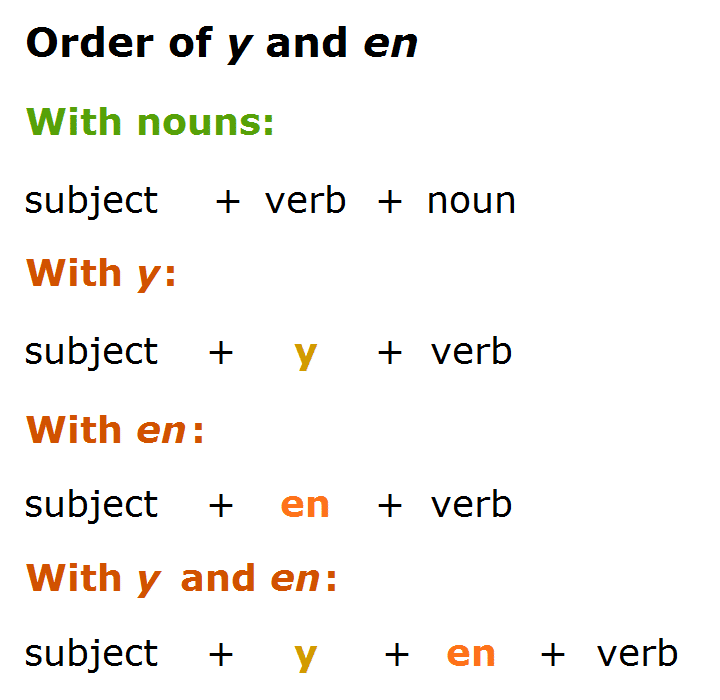
Y and en are pronouns in French. Generally, y (pronounced like the letter “e” in English) means “there” and en means “some”, but they have many alternate translations as well. They are often taught later in textbooks than direct and indirect object pronouns, though their purpose conceptually is similar.

These pronouns, just like direct and indirect object pronouns, 1) replace something and 2) take “unusual” places in sentences compared to how the word would be positioned in the equivalent sentence in English.
Using Y and En with Verbs
Using y and en with verbs can be confusing because using them requires thinking about which prepositions various verbs in French “take” (if any).
What this means: just as in English, prepositions often follow verbs, and the sentence won’t make sense without the preposition being included.
Sometimes there is only one preposition that normally follows a specific verb in English.
I searched for her purse.
Sometimes different prepositions give different meanings for the verb.
He looks at the dog.
We are looking forward to tomorrow.
And some sentences do not take prepositions at all.
She runs and plays tennis.
French is the same way, with certain verbs taking certain prepositions, but it is critical to note that they aren’t the same verbs in French as they are in English.
- For example, in English, you look for something (“look” + “for” + direct object) but in French you chercher quelque chose (there is no pour (“for”) in the construction).
- On the other hand, in English you “use” + direct object, but in French the construction is se servir de + direct object.
When using pronouns with these verbs, the verbs that are followed by à will use the pronoun y. Verbs that take de will use the pronoun en.
Je m’intéresse au tennis. (“I am interested in tennis.”) → Je m’y intéresse. (“I am interested in it.”)
Elles se servent de l‘information sur l’examen rarement. (“They use the information on the exam rarely.”) → Elles s’en servent rarement. (“They rarely use it.”)
Other uses of y in sentences
There are several other circumstances in which y is used in sentences, thankfully in ways that require a little less mental effort than having to think about specific verb constructions.
Y in set phrases
In a few common phrases in French, there is no good direct translation for what y means in the sentence.
Il y a (“There is”, “There exists”, “There are”)
Pensez-y (“Think about it”)
Y as “there”
Y can also specifically mean “there”. It precedes the verb just as other pronouns do in French.
It follows sentences set up with many prepositions of location, including sur, dans, à, en (when referring to a place), sous, and similar prepositions. However, it only applies to inanimate objects and cannot be used to apply to people (instead you would use the equivalent indirect object pronoun).
Vous avez habité dans cette ville. (“You lived in this city”) → Vous y avez habité. (“He lived there”)
Nous habitons en France. (“We live in France.”) → Nous y habitons. (“We live there.”)
Other uses of en in sentences
Like y, en is used in many ways in French (including en in terms of being located in feminine countries, such as the phrase en France). Below is just a discussion of how it is used as a pronoun.
En as part of a de construction
En is used in sentences that contain de + direct object. When the pronoun refers to a person, en can be used, but in spoken French, speakers often use de + indirect object pronoun after the first part of the sentence.
Il est fier de son succès. (“He is proud of his success.”) → Il en est fier. (“He is proud of it.”)
Il est fier de son fils. (“He is proud of his son.”) → Il en est fier. / Il est fier de lui. (“He is proud of him.”)
En as “some” of a number or quantity
En is also used to replace “some” of a number, referring to a number + de + noun phrase. In English, the “of” + something is frequently left off when using a pronoun, but in French it must always be present.
Il a trois des affiches (“He has three of the posters.”) → Il en a trois (“He has three of them.”)
J’ai cinq chats. (“I have five cats.” Notice that the word de is not present.) → J’en ai cinq (“I have five (of them).”)
In a similar way, en is used to replace words that quantify in general terms the amount of something. Words this applies to include beaucoup, certains, plusieurs, and trop. These words are always followed by de + noun, which means en should always be used when replacing the noun with a pronoun. Again, the “of” is frequently omitted in English but is required in French.
Tu as plusieurs de peintures. (“You have several paintings”; also notice that de is not present in the equivalent phrase in English.) → Tu en as plusieurs. (“You have several of them.”)
Nous avons acheté trop de vêtements (“We bought too many clothes.”) → Nous en avons acheté trop. (“We bought too many of them”; note that both parts of the passé composé construction follow en.)
Set phrases with en
Like many other common words in any language, there are set phrases that develop over time with these words to have a meaning that does not match a direct translation and instead means something specific as a complete phrase. Here are some of the more common en phrases.
S’en aller (“to go away”)
En voilà un (“there is someone”)
C’en est fait (“that’s the end of”)
Using y and en
In summary: 1) remember that if you’re going to use a pronoun as applying to a verb, you need to keep the verb structure in mind so you can use the correct pronoun, if either is necessary; 2) only use y for inanimate objects, and 3) in the rare occasions that you use both within a sentence, the order is y followed by en.



